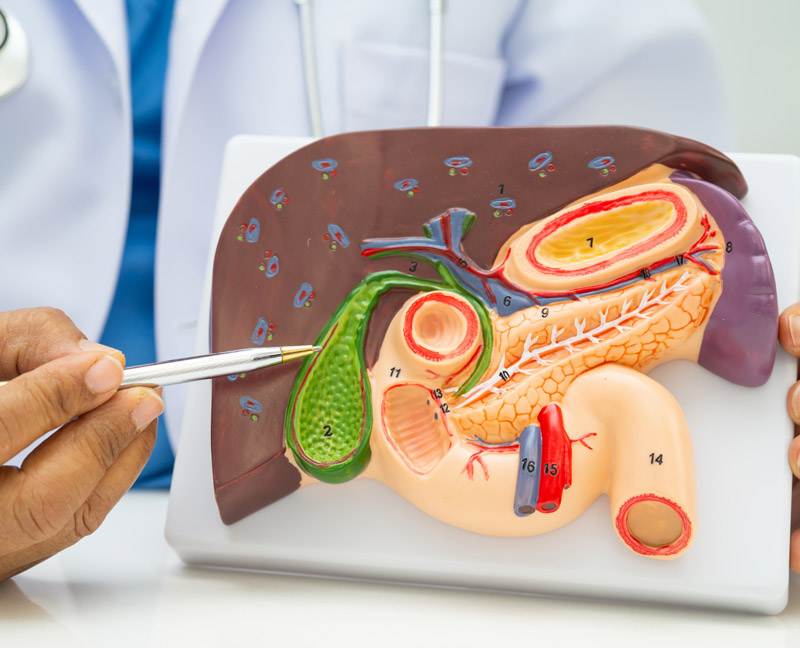When the Gallbladder Causes Trouble: Gallstones and Gallbladder Surgery

Most people don’t think much about their gallbladder—until it starts causing pain. This small, pear-shaped organ sits just under the liver and helps digest fat by storing and releasing bile. When something goes wrong, such as the formation of gallstones, it can lead to intense discomfort and potentially serious complications. The good news is that gallbladder problems are common, well understood, and highly treatable.
Understanding Gallstones
Gallstones are hardened deposits that form inside the gallbladder. They can range in size from a grain of sand to a golf ball, and some people have just one while others have many.
“Gallstones develop when substances in bile, such as cholesterol or bilirubin, become unbalanced,” explains Shore Physicians Group General Surgeon James J. Tayoun, DO, FACOS. “They can block the normal flow of bile, causing pain, inflammation, or infection.”
Certain factors make a person more likely to develop gallstones. These include being female, being over age 40, and having a family history of gallstones. Obesity, rapid weight loss, and diets high in fat and cholesterol also raise the risk, as do certain medical conditions such as diabetes.
Gallstones are typically diagnosed through an ultrasound or other imaging test. Some people have gallstones without symptoms and may not need surgery, but when pain or complications occur, removal of the gallbladder is usually recommended.
Signs You Might Have a Gallbladder Problem
Gallbladder attacks often occur after eating a fatty meal, though pain can happen at any time. The discomfort is typically felt as a sudden, sharp pain in the upper right or middle of the abdomen, and it may radiate to the right shoulder or back. Some people experience nausea, vomiting, bloating, or indigestion after eating.
“If you experience severe or recurring abdominal pain—especially if it lasts more than a few hours or is accompanied by fever or vomiting—you should seek medical attention,” says Dr. Tayoun. Untreated gallstones can lead to serious issues such as infection, bile duct blockage, or pancreatitis, so early evaluation is important.
When Surgery Is the Best Solution
In many cases, the best long-term solution for gallstones or chronic gallbladder inflammation is surgery to remove the gallbladder, known as a cholecystectomy.
“Gallbladder removal is one of the most common and safest surgeries performed today,” says Dr. Tayoun. “Most procedures are now performed using a surgical robot, which provides better visualization, more precise movements, and a lower likelihood of needing to convert to open surgery. Minimally invasive laparoscopic surgery is also an option, with smaller incisions, less pain, and faster recovery.”
A robotic or laparoscopic gallbladder surgery typically takes about 45 minutes to one hour, and patients usually spend a few hours in recovery before heading home the same day. Some cases require an open surgery, which involves a larger incision and a slightly longer recovery period, but this is less common.
Most people return to normal daily activities within a week or two, though it’s best to avoid heavy lifting for several weeks. The body continues to function normally without a gallbladder because the liver still produces bile that flows directly into the intestine to aid digestion.
Living Well After Gallbladder Surgery
After surgery, most people notice that their digestion improves and that the painful attacks are gone. Dr. Tayoun recommends gradually reintroducing fatty or fried foods and focusing on a balanced diet rich in lean proteins, fruits, vegetables, and whole grains.
“Recovery is usually smooth, and the relief from symptoms can be life-changing,” he says. “The key is not ignoring warning signs and getting evaluated early.”
While most people have no lasting effects from gallbladder removal, a small number may experience temporary changes in digestion. These symptoms are typically mild and improve as the body adjusts.
When to See a Surgeon
If you’ve been told you have gallstones or you’re experiencing frequent abdominal pain, schedule a consultation with a general surgeon. “Early evaluation helps prevent complications such as infection or pancreatitis,” says Dr. Tayoun. “We can discuss whether surgery is right for you and make sure you get the care you need safely and efficiently.”
About James J. Tayoun, DO, FACOS
Dr. James J. Tayoun is a Penn Affiliated General Surgeon with Shore Physicians Group who specializes in advanced minimally invasive procedures for conditions affecting the stomach, colon, and vascular system. He treats acid reflux, hernias, diverticulitis, colon tumors, gallbladder disease, aortic aneurysms, varicose veins, and peripheral artery disease.
He sees patients at Shore Physicians Group Surgical Division, 649 Shore Road, Somers Point, NJ 08244.
To schedule an appointment, call 609-365-6239.